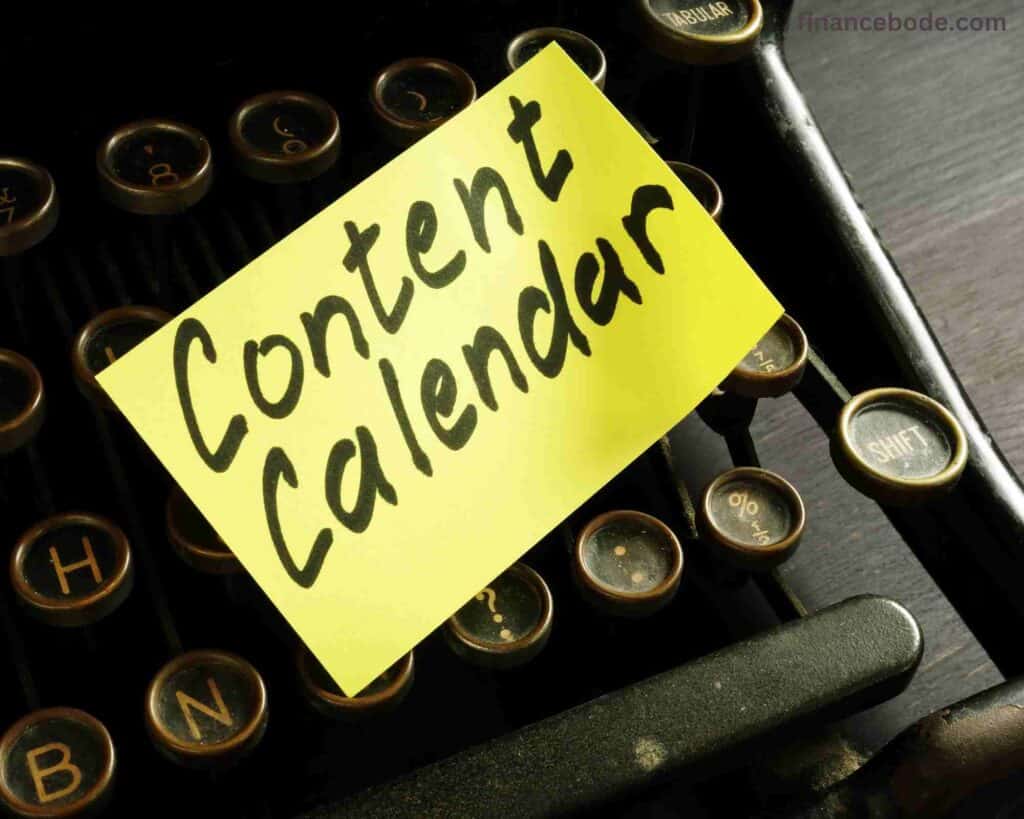It’s a must for you to know how to create an editorial calendar for the blog!
“But what should I write about?” or “What can I write now in a hurry?”
These are questions I asked myself quite often in my early days of blogging. Due to the fact that I don’t know have an editorial calendar for my blog.
Be honest – how well is your blog content performing? Does your blog have a solid following, and does it continually produce new readers?
If that’s not the case,
The answer is to create an editorial calendar and plan content for your blog in advance.
An editorial strategy lets you organize your thoughts to be great for you and your audience.
Imagine you want to learn an entirely new subject. Let’s say macrame.
So you start Googling (something like “macrame for beginners”) and arrive at a diy9993 blog explaining how to learn macrame.
The initial impression is amazing – so you keep reading. You read something about lark’s head knot, square knot, spiral knot, and half hitch.
An explanation of what is hidden behind the phrases or how to build these knots? It is not available in the blog.
The blog piece leaps right from macrame to knitting. You will only comprehend the railway and leave the blog disappointed.
Do you know what causes this? Lack of an editorial plan.
Let’s look at it together now.
See also: What you should know about Blog Publishing Plan.
What Is An Editorial Plan/ Calendar?
An editorial plan is a blueprint for your content marketing. You use it to arrange the content of all your channels (blog, social media, newsletter, etc.).
That implies your words, films, podcasts, and interviews. But In this article, we’ll concentrate on blogs.
Let’s go back to our macrame example. Our diy9993 blog appears to have only done the planning of their content half-heartedly, despite all their affection.
Had she pushed harder, she would have immediately understood that a report on the different knots should have followed the how-to article.
A suitable sequence of blog posts may have looked like this:
1. Learn macrame – all you need to know
2. The 6 most essential knots and how to tie them
3. What you should consider while picking your macrame yarn
4. Macrame for beginners: create coasters yourself
5. Make a basic macrame hanging basket yourself
And so on. So diy9993 would have lifted you up as a reader and taken you by the hand.
You probably couldn’t stop reading since each blog piece would have lured you further into the macrame world.
So, as I stated before, An editorial strategy enables you to arrange your thoughts and ideas.
But not just that.
What Are The Advantages Of Creating An Editorial Calendar For a Blog?
If you’re reading this, you’re more inclined to create your content from gut instinct. It CAN work – but regrettably, it doesn’t in most circumstances.
So let’s take a look at why an editorial strategy is so helpful.
You always know just what to write about next.
If you want your blog to be a big hit, you need quality posts on a regular basis. So you decide to write 5 articles like this once a month.
A peek at the calendar shows: It’s now the 25th, and you haven’t written anything. Damn! So you urgently delve into the depths of your brain for a wonderful subject. Pure stress.
With an editing strategy, you simply sit down, gather, and place everything in a logical sequence. You can then start writing later without having to think twice.
You prevent writer’s block.
A totally empty document with a deadline that is coming closer and closer. But your brain is at least as empty as the (virtual) white sheet in front of you.
White pages frequently obstruct me. So that this doesn’t happen at all, I have my editing strategy. That way, I can at least jot down the title and start studying. Then the texts generally compose themselves.
You blog regularly
Regularity is one of the keys to blogging success. Firstly, Google, Instagram, Pinterest & Co. appreciate it when there is constantly fresh material.
And secondly, your audience always wants to see something new from you.
When you plan your content, you know precisely what needs to be ready by when and you can incorporate content production into your to-dos properly.
You may find out more about how to blog frequently in my blog post.
You keep track
What did I publish and when? Which article has to be ready by when? And have I actually ever written about the topic XY?
Your editorial plan gives you the answers to all these questions.
If you also archive the topics you have already worked on in your plan, you avoid duplication and never have to search for a long time.
Your blog follows logic.
Do you want your viewers to be able to grasp your articles? Then stack them up on each other. Start with the essentials, then steadily work your way down to the specifics.
Good preparation helps to prevent going from A to F and back to B.
This also decreases the possibility of your readers abandoning your site since they are more contented following your content than before.
You retain your concentration.
There are so many subjects you would want to talk about, and I’m sure you’ll cover them all – but first things first.
If you want your content to grow on each other, don’t allow the billions of ideas to distract you. Your editorial strategy enables you to continually keep an eye on your common thread.
You can plan beforehand.
As I write this blog post, my bag is already half-packed in the bedroom. It’s July vacation time.
I think that you, too, will treat yourself to a brief break in the coming few weeks (or have already done so). What’s up with your blog? Of course, you can also take a rest here.
OR: You prepare everything and post blog pieces (that is, fantastic content that attracts the attention of prospective clients to you) while you are resting on the beach without having to open your laptop.
With an editorial schedule, you know precisely when everything should be online, and you can have everything ready on time for holidays, debuts, or other significant events.
And no, you don’t lose flexibility (your plan isn’t written in stone), and no, it doesn’t take a lot of time.
As soon as you are in the flow and have become acclimated to the planning, everything runs virtually by itself.
Disadvantages Of An Editorial Plan
I wouldn’t be honest if I didn’t confess that there may be a few disadvantages to the editorial calendar. However, I am of the belief if proper planning is necessary, then they are virtually unimportant…
- • Effort
Just like blogging doesn’t operate by itself, the editorial strategy doesn’t plan itself either. But once you get the hang of it, you save time again since last-minute blog idea search sessions are canceled! 😉
- • Flexibility
If you have a predetermined sequence for your blog entries, it is often tough to toss everything overboard and reorganize it at short notice.
The solution: If you know this occurs to you regularly, create placeholders for spontaneous subjects.
- • Change of mind
If you prepare extensively in advance, you may not find a concept as fascinating after all. Feel free to remove these subjects or replace them with backup blog articles!
- • Wrong system
If you don’t plan correctly, it might happen that you place too much strain on yourself; plan beyond your readers…
How To Create An Editorial Calendar For Blog
Creating an editorial strategy is not rocket science.
You can create an editorial plan for all channels or a plan for individual channels. If you pick the second version, you have to make sure that all channels are synced.
No matter how you begin, your editing strategy requires the following parts :
Goal
Very important: What should your readers do after reading? Write a remark, subscribe to the newsletter, purchase a product? Your wording should be aligned with your purpose.
Target audience
Who precisely are you writing your essay for? Beginners, advanced, pros? What previous information do you already have? What more do you have to explain? What are your challenges?
Also, think about where your readers are on their customer journey so that you can support them in the best possible manner with your content.
Publication date
When do you want the blog piece to go published on your website? Also, bear in mind that you may have to get the item authorized by other authorities. Set a deadline for the creation.
Working title
Don’t spend time attempting to discover the right title in the beginning. This occurs throughout the writing and frequently changes again. Provide a title here so that you know precisely what it’s about.
Content
What should it be approximately about? Are there any things that you definitely wish to mention? Write them down here.
If there are many authors: Responsible
An editorial strategy is a fundamental core when you collaborate with numerous individuals on a blog.
Therefore, additionally indicate specifically who is accountable for a particular item. Not that there will be duplicate articles or (much worse) that one will be forgotten.
Keyword(s)
Make a list of critical keywords that your writing really requires. You don’t need to conduct much research here. A quick brainstorming is adequate.
So that you don’t lose track of things while planning, each item also requires a current status.
What Needs To Be In An Editorial Plan
What information your editorial strategy includes is up to you because you have to work with it at the end of the day.
For the smart editorial plan that I made for my blog, you simply need an Excel table or Google Sheets table with the following structure:
• 1 spreadsheet for post ideas, analysis, and planning
• 1 worksheet for an unsorted collection of ideas
In the second spreadsheet, you just gather all the ideas that come to mind, that you investigate, etc. After that, the most significant work on the real editing sheet takes place in the first spreadsheet.
The editing plan covers the following information:
• Publish Date
When should the blog article be published?
• Post Idea / Topic
Write down your post idea. Try to shape them as nearly as possible to a suitable post title. But don’t linger on it needlessly. You may easily modify the title later while composing your blog article.
- • Outline
Which sub-topics do you wish to address in your blog post? What is related to the post topic? Note them here.
- • Main keyword
On which major keyword (focus term) do you want to optimize your blog post?
- • Related keywords
Write down 3-5 similar keywords and synonyms to your core keyword.
- • Search Volume & SEO Difficulty
Write down the search volume (how frequently it is looked for every month) and the SEO Difficulty (rank difficulty with the primary keyword) of your main keyword.
- • Competitors
Make a note of your 3 key rivals (link to the corresponding blog article).
- • Average Word Count
Write down the average word count of the sites that rank for your core keyword in the top 5 search results on Google. You may observe it using the free tool “Keyword-Surfer” (approximately).
- • CTA (call to action)
What action do you want your viewers to take after reading the blog post? E.g., download your freebie, purchase your product, share your blog article, and comment,… Write it down here.
- • Related Blog Posts
Do you have any blog entries linked to this subject or one of your subtopics from your outline? Note them here.
So you have everything at a glance and just have to compose the articles afterward.
Which Tools Can I Use For My Editorial Plan?
However, there are roughly 13 techniques to develop an editorial strategy, all of which have their features.
As so frequently, you have to select the one that you feel most comfortable with. So don’t despair if your first try isn’t 100% successful.
Today I will show you the four most reliable tools for your content strategy.
Offline planner/calendar
Let’s start simple and old-school. You grab a calendar and fill it out by hand. It doesn’t matter if you use a book calendar, a pocket calendar, or a wall calendar.
In the early beginning, I always got gorgeous calendar layouts from Canva and put everything there.
If it’s vital to you that you work with paper and you simply want something to touch, you’ll do very well with this strategy.
Asana
Project management solutions such as Asana are also perfect for an editing strategy.
Here you can give various colors to your categories; you can quickly shift blog post ideas back and forth and therefore adjust and adapt your plans.
You can also quickly add additional persons or your team and give tasks to them.
Excel file
With variation two, we are going digital. You just create an Excel spreadsheet. The fortunate thing is: There are now fantastic templates for this that guide you straight to significant and fascinating “holidays.”
Here you have the chance to arrange both your content and distribution (blog, social media, newsletter,…) in one single spot. You can also make a separate sheet for each month.
Google Spreadsheets
Google spreadsheets are practically the same as Excel – but in a cloud. This implies that your editing plan is no longer simply kept locally on your PC, but you can access it from anywhere.
Trello
The fourth choice is a project management tool. My heart beats for Trello: It’s free, straightforward, easy to comprehend, and just incredibly useful!
In the initial step, you register. When you arrive at your dashboard, you may build your boards. I propose building a different board for each channel.
For example, I have a blog, newsletter, Instagram, LinkedIn, and Pinterest.
You can then construct lists (= major categories) on the individual boards. Depending on the station, they might be extremely different.
This is the plan for my blog. In addition to the articles that have previously been scheduled, I also gather all my ideas here — categorized by topics.
I initially began with a paper calendar, then went on to Excel, and have landed at Trello for a few years now. So you can see that the manner might also vary.
Just try what fits you best. None of the tools is better or worse.
How Long In Advance Should I Plan?
There is no right or incorrect answer to this issue, no silver bullet (as one of my English instructors used to say).
It’s about choosing an interval that you’re comfortable with.
I can offer you an insight into my planning:
At the beginning of the year, I set out a basic plan. I think about which themes would make sense when and if there are seasonal events (e.g., spring cleaning or summer doldrums).
I also arrange my launches for this since I normally also prepare synchronized blog pieces.
I establish a more firm plan for the first six months (yeah, I’m a planning obsessive). The remainder is a process in which I constantly add, move and remove new content.
So you see: Editorial planning is dynamic.
I developed a list of ideas for this. I input anything that comes to my head and leave it till the next planning step. For example, if I read a question in a Facebook group that appears to be of importance to many, the issue gets on my list.
Some of the things I may never use, but I can fall back on them in an emergency. In my planning stages, I then organize the issues that I believe are most relevant to the editorial plan.
But please bear in mind: This is simply my plan, my pleasure zone.
If it seems better to plan for three months, that’s good too. See the editorial strategy as a common thread that you may grasp that supports your vision.
And another tip: the longer you plan ahead, the longer you enjoy peace of mind (and still fantastic content).
Conclusion
I suppose you’ve already noticed: I’m an extreme editorial plan enthusiast! I’m constantly looking forward to finally being able to plan again, and then I can’t wait till I can finally incorporate all the stuff.
Even if you haven’t been a huge lover of planning so far, I highly urge that you at least construct a preliminary editorial plan. This saves you time and anxiety and delivers material that is much better.
Editorial planning may seem like your brain has to be in top shape here, but you don’t have to. Just check out the numerous varieties and pick which one fits you best.
Once a month, I take the time to refresh my editorial agenda with new ideas. But I also work a lot with it in between to shift the individual cards in Trello over and again.
Postponing has become a replacement medication for checking off to-dos. You feel this extremely particular pride when you realize what you have already done.
And don’t forget: Just because it’s in the editorial plan doesn’t imply that you can never modify anything about the subject again.
FAQ About Blog Editorial Calendar
What does an editorial plan look like?
The editorial strategy may be simply controlled in an Excel spreadsheet. The publishing dates are placed in the left column, and the top line includes all essential information (subject, the person responsible, keywords, content type, target audience, etc.)
Why is an editing plan necessary?
An editorial plan is an integral aspect of the content strategy in most firms. It is the foundation for all content-related operations and should be maintained and updated periodically.
The editorial calendar gives an overview of all planned themes, formats, channels, and target groups. This makes prior planning simpler and saves duplication of labor.
In addition, an editorial schedule guarantees that essential themes are not lost in the rush and bustle.





